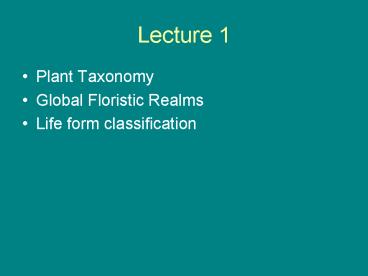Plant Taxonomy - PowerPoint PPT Presentation
1 / 24
Title:
Plant Taxonomy
Description:
Taxodium (Cypress) Sequoia. Cupressaceae. Thuja (Eastern White Cedar) Juniperus (Juniper) ... Much more sharply differentiated among floristic realms than are ... – PowerPoint PPT presentation
Number of Views:587
Avg rating:3.0/5.0
Title: Plant Taxonomy
1
Lecture 1
- Plant Taxonomy
- Global Floristic Realms
- Life form classification
2
Biological Kingdoms
- Monera
- Protista
- Fungi
- Animalia
- Plantae
3
Taxonomic Hierarchy
- Kingdom
- Phylum (Division)
- Class
- Order
- Family
- Genus
- Species
4
An Example of the Taxonomic Hierarchy
5
A Plant Example
6
Comparison
7
Global Floristic Realms
- Regions that differ fundamentally from one
another in the types of vegetation found there.
8
Global Floristic Realms
9
(No Transcript)
10
Angiosperms and Gymnosperms
- Gymnosperms are phylogenetically older.
- Angiosperms are the youngest branch of the plant
kingdom.
11
Hemispherical Differences
- Northern Hemisphere
- Pinaceae
- Pinus (Pine)
- Abies (Fir)
- Picea (Spruce)
- Larix (Larch)
- Taxodiaceae
- Taxodium (Cypress)
- Sequoia
- Cupressaceae
- Thuja (Eastern White Cedar)
- Juniperus (Juniper)
- Southern Hemisphere
- Podocarpaceae
- Cupressaceae
12
Pinus
13
Angiosperm Differentiation
- Much more sharply differentiated among floristic
realms than are the gymnosperms. - Main development occurred during the Tertiary (65
2 million years ago). - Occurred after the continents had separated.
14
The Holarctic
- Angiosperms in the northern hemisphere are fairly
similar. - North America and Greenland didnt separate from
Eurasia until the Pleistocene (c. 2 million b.p.)
15
Raunkiaer Classifications
Physiognomic method based on the height above
ground of the perennating buds. This
classification is based on the assumption that
species morphology is closely related to climatic
controls.
- Phanerophytes
- Chamaephytes
- Hemicryptophytes
- Cryptophytes
- Therophytes
16
Phanerophytes
- Species with perennating buds emerging from the
aerial parts of the plant. - Megaphanerophytes (gt 30m)
- Mesophanerophytes (8 30 m)
- Microphanerophytes (2 8 m)
- Nanophanerophytes (lt 2m)
17
Chamaephytes
- Species with perennating buds borne on aerial
parts close to the ground (below 2m) - Suffruticose chamaephytes after the main growth
period, upper shoots die so that only the lower
parts of the plant remain in the unfavorable
period. - Passive chamaephytes at the onset of adverse
conditions, shoots weaken and fall to ground
level, becoming procumbent. This gives them some
protection from environmental stress. - Active chamaephytes shoots are only produced
along the ground and remain so in the unfavorable
season. - Cushion chamaephytes a modification of passive
types where shoots are arranged so close together
that they cannot fall over and the close packing
of all shoots forms a cushion.
18
Hemicryptophytes
- All above-ground parts of the plant die back and
buds are borne at ground level. - Protohemicryptophytes leaves become better
developed up the stem of the plant. Poorly
developed leaves protect the bud in early stages
of growth. - Partial rosette plants the developmed leaves
form a rosette at the base of the plant in the
first year of growth. The following year an
elongated aerial shoot may form. - Rosette plants leaves are restricted to a basal
rosette with an elongated aerial shoot, which is
exclusively flower-bearing
19
Cryptophytes
- Plant species with buds or shoot apices which
survive the unfavorable period below ground or
under water. - Geophytes plants with subterranean organs such
as bulbs, rhizomes and tubers from which shoots
emerge in the next growing season. - Helophytes plants with their perennating buds in
soil or mud below water and which produce shoots
reaching above water. - Hydrophytes species with buds which lie
underwater and survive the unfavorable season by
budding from rhizomes under water or from
detached vegetative buds which sink to the
bottom.
20
Therophytes
- Plants that survive the unfavorable period as
seeds.
21
Raunkiaer Examples
22
Biological Spectra
23
SavannaOlokomeji Forest Reserve, Nigeria
24
Tropical RainforestBritish Guiana






























